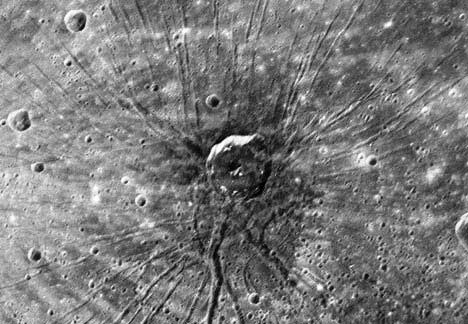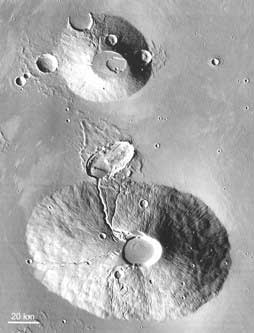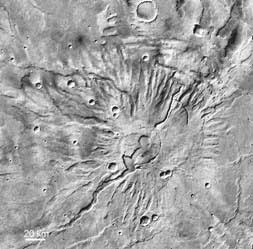Mercury’s “spider” – another
giant caldera volcano? |
|
G.J.H.
McCall
44 Robert Franklin Way, South Cerney, Glos. GL7
5UD
joemccall@tiscali.co.uk
Dr Joe McCall, retired,
is a former Reader (Associate Professor) of
Geology at the University of Western Australia.
He also curated the meteorites at the Western
Australian Museum during his time in Perth.
Besides his professional work on terrestrial
geology he has long had an interest in the extraterrestrial
extensions of geology, to the Moon, Mars, Mercury
and other bodies in the Solar System. He was
recently leading editor of a history
of Meteoritics and
key collections, published by the Geological
Society of London, of which he is a Senior Fellow.
He was awarded its prestigious Coke
medal in
1994. |
 Click here to
download a PDF version of this webpage Click here to
download a PDF version of this webpage
This letter reports the discovery,
by means of comparison of a MESSENGER image of part
of the Caloris Basin, Mercury, with images of Martian
caldera volcanoes, of a very large caldera volcano. The
structure, which has been called "the spider" informally
by the MESSENGER team, and has hitherto been unexplained,
is ~330 km in diameter and shows remarkable similarities
to the giant Martian caldera volcanoes Ceraunius Tholus,
Uranius Tholus and Tyrrhenia Patera.
I have long had an interest in Mercury
and regretted its long neglect without follow-ups to
the Mariner 10 visit1. I have also written
about the giant caldera volcano of Olympus Mons on
Mars2. Mercury’s
newly revealed and surprising image of a structure
within the Caloris Basin, informally named "the
spider" by the MESSENGER team, was recently
discussed in Science
Daily, as downloaded
from the Web on 13.3.083 (Figure
1).

Figure 1: "The spider",
revealed in an image sent back by MESSENGER, 14.1.2008.
The volcano, circumscribed by a faint, white annular
mark, is about 330 km in diameter (from ref.
3 ).
I quote from the
above-mentioned webpage:
"MESSENGER obtained high-resolution
images of the floor of the Caloris basin on January
14 2008. Near
the center of this basin, this remarkable feature
– named "the spider" by
the science team – was revealed. A set
of troughs radiating outward are interpreted to be
the result of the breaking apart of the floor materials
that filled the Caloris basin after its formation.
Other troughs near the center form a polygonal pattern.
An impact crater 40 km (25 miles) in diameter appears
to be centered on "the spider" (Credit
NASA/St Johns Hopkins University Applied Physics
Laboratory/Carnegie Institution of Washington).

Figure 2: Uranius Tholus (top,
~ 60 km in diameter) and Ceraunius Tholus (bottom,
~ 130 km in diameter), both on Mars. The
radial and later sinuous channels suggest that
the material was easily erodable ash, rather than
lavas. The steep conical piles support this inference
(THEMIS MOSAIC). |
I am familiar with calderas, having described
Menengai5, Suswa6, Kilombe7 and
Silali8 caldera volcanoes in the Kenya
Rift Valley, and Ambrym caldera in Vanuatu8.
Fortuitously, I recently reviewed Michael Carr’s
excellent re-issue of his book
on Mars, with its superb images of Martian
caldera volcanoes4 – this
review will be appearing shortly in Geoscientist. NASA
interpreters have apparently neglected to study
images of caldera volcanoes on Mars for comparison.
First, look
at the Mars volcanoes Ceraunius Tholus and Uranius
Tholus (Figure 2). These are ideal examples of
caldera volcanoes ~60 and ~130 km across, with
summit calderas ~12 and ~25 km across. The
original volcanoes produced voluminous material
in both cases and built up massive cones with
well-defined circumferential margins. Both have
radial fissures which I suggest were formed in
the tumescent stage. Both
have fewer and wider sinuous grooves or troughs,
formed slightly later, and lastly they have summit
calderas, formed in the relaxation stage. Uranius
has two calderas, nested. Ceraunius has
a single caldera.
|
Now look at the image of Tyrrhena Patera, which
is a less ideal case (Figure 3). The volcano
measures ~200 km across and the caldera 40 km
across. The volcanic pile is flatter and
wider, and there is less contrast with the surroundings
because the output was of different material
and had less colour contrast. Here there
is a radial pattern of fissures but they are
wider grooves or troughs. There are two later,
sinuous grooves or troughs, both wider and one
of these passes smoothly into the caldera floor.
The caldera is complex (one could even suggest
that there are two calderas interconnected).
There is also a partial concentric narrow ring
groove which is clearly cut off by the complex
caldera. This partial annular groove was probaly
formed early in the relaxation stage, prior to
the subsidence of the caldera.
|

Figure 3: Tyrrhena Patera on
Mars (~200 km in diameter). This is a flatter
cone than Ceraunius and Uranius Tholus, but is
thought to be composed of horizontally bedded
ash deposits. The caldera and a flat-floored
trough merge into one another (MOC WA). |
Now look at "the spider"
on Mercury. Again, as in the case of Tyrrhena,
partial circumferential markings show up, here white
and discontinuous. The image is chopped off, and the
outer margin is barely seen, but at "two o'clock" the
radial grooves seem to die out. This suggests a diameter
of ~330 km, though it could be more. This structure
is larger than the three Martian volcanoes I
discuss here, though not the pile of Olympus Mons on
Mars2 which
has a diameter ~550 km. Mercury is only 2/3 the diameter
of Mars, but both these smaller-than-Earth planets
apparently display volcanic giantism. Mt. Kenya and
Kilimanjaro, among the largest terrestrial volcanoes,
have diameters of only ~80 km. Mauna Loa, on Hawaii,
is larger if one measures from the sea floor. It is
probably the highest terrestrial volcanic pile, at
about 200 km.
"The spider" displays almost
straight radial fissures of the tumescence stage. in
this it resembles Ceraunius and Uranius on Mars. There
are wider, more irregular grooves that formed later
than these, and one, as in the case of Tyrrhena, appears
to run smoothly into the caldera floor. The wall of
the caldera has the form of an irregular circle – this
irregular, subpolygonal form is like that of many terrestrial
calderas – only Ambrym of the calderas that I
have mapped, and the caldera of Longonot, Kenya (with
which I am familiar but did not map) is a neat, circular
basin. The contrast of the material forming the volcanic
pile with its surroundings is poor, but there is a
darker, irregular area in the middle of the slopes.
Flatter volcanic piles on Earth are produced by shield
volcanoes made up of lava flows, but this might not
apply to Mercury. The detail revealed by MESSENGER
is far less than that revealed on the Martian images,
and this structure will surely reveal much more interesting
detail in the future, like Ceraunius, Uranius and Tyrrhena,
when an Orbiter can get close enough to reveal comparable
images.
I believe that "the spider" represents
a huge caldera volcano of a relatively late stage
in the moulding of Mercury’s crust. Is it the
first such giant volcano to be detected on this innermost
planet? The presence of a huge caldera
volcano in the centre of the Caloris basin is interesting.
This vast basin, for which a diameter of 1550 km has
been suggested9, has been supposed to be
an impact structure, produced by an impactor of asteroidal
dimensions. However, the evidence for an impact origin
of the huge Lunar Maria, Hellas
basin on Mars, and Caloris Basin on Mercury, appears
not to be very substantial.
References
-
McCall, G.J.H. 2006. Mercury. In; Selley,
RC, Cocks, L.R., Pilmer, I.R.; Encyclopedia
of Geology,
5, 235-244.
-
McCall, G.J.H. 2006. A caldera volcano
of Brobdingnagian scale: Olympus
Mons. Geoscientist 16(4); 29-30..
-
-
-
McCall, G.J.H. 1967.
Geology of the Nakuru-Thomsons Falls-Lake Hannington
Area. Report No. 78, Geological
Survey of Kenya, 122 pp.
-
McCall, G.J.H. and Bristow,
C.M. 1965. An introductory account
of Suswa Volcano. Bull.
Volcanol. 28; 1-35
-
McCall,
G.J.H. 1964. Kilombe caldera, Kenya. Proc.
Geologists’ Association 75, 563-572.
-
Smith, M., Dunkley, P.N., Deino.A.,
Williams, L.A.J., and McCall, G.J.H. Geochronology,
stratigraphy and structural evolution of Silali
volcano, Gregory Rift, Kenya. Journal
of the Geological Society 152;
297-310.
-
Shiga, D. 2008. Bizarre
spider scar foundon Marcury’s surface. New
Scientist. com news service 30 January.
last updated 8th
April, 2008 |
